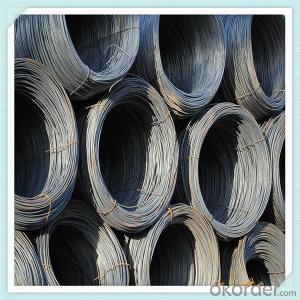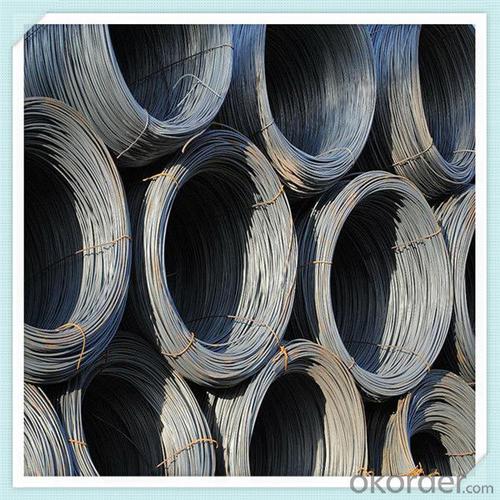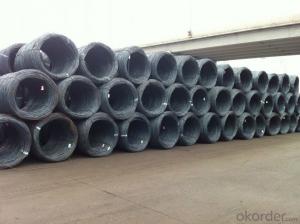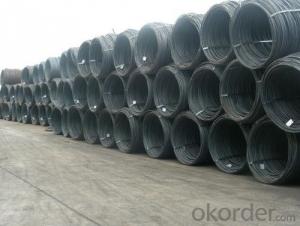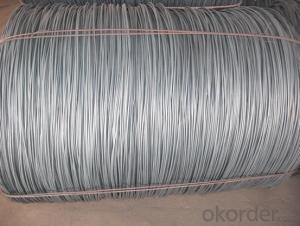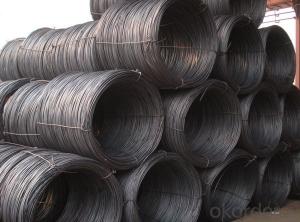SAE1012 5.5-14MM Steel wire rod hot rolled
- Loading Port:
- Shanghai
- Payment Terms:
- TT OR LC
- Min Order Qty:
- 100 m.t.
- Supply Capability:
- 14500 m.t./month
OKorder Service Pledge
OKorder Financial Service
You Might Also Like
Specification
Features
1、Pure steel quality, stable chemical contents, small tolerance.
2、Constant Quality, good drawing performance.
3、High dimension accuracy degree, accuracy degree of Level C up to 80%, smooth surface, less scale,
easy to be pickled.
4、Automatic bundling with 4 lines by Machine in tidy and good looks
5、Big high quality percentage, small coil percentage, and heavy coil weight for Hard Coil.
6、High sorbitizing percentage.
Drawing Grade wire rods are used by downstream industries for various applications such as making
wires for welded mesh, nails, hangers, screws, chain link & gabion fencing, wire nets, barbed wires
and binding wires.
Product Description :
Standard | AISI, ASTM, BS, DIN, GB, JIS |
Material/steel grade | Q195-Q235,SAE1006B,SAE1006CR, SAE1008B, SAE1008CR, SAE1010B, SAE1018B, or according to customers requirements |
Wire Gauge | 5.5-12mm |
Coil weight | 1.8-2.1mts |
MOQ | 25MT |
Delivery Time | 15-30 days after receipt of L/C or deposit by T/T |
Packing | In coil and load in container, if large quantity, by bulk vessel; Can be packed as customers' special requirements |
Payment terms | 1).100% irrevocable L/C at sight. 2).30% T/T prepaid and the balance against the copy of B/L. 3).30% T/T prepaid and the balance against L/C |
Application | widely used in machinery parts, manufacturing industry, electronics industry, metal tools and others |
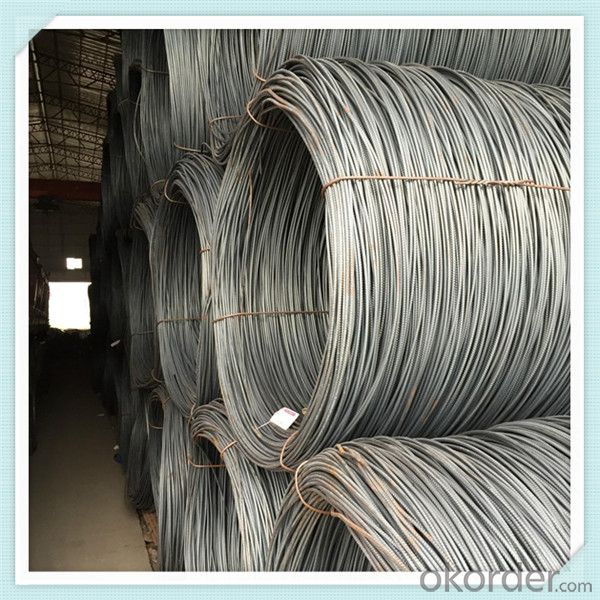
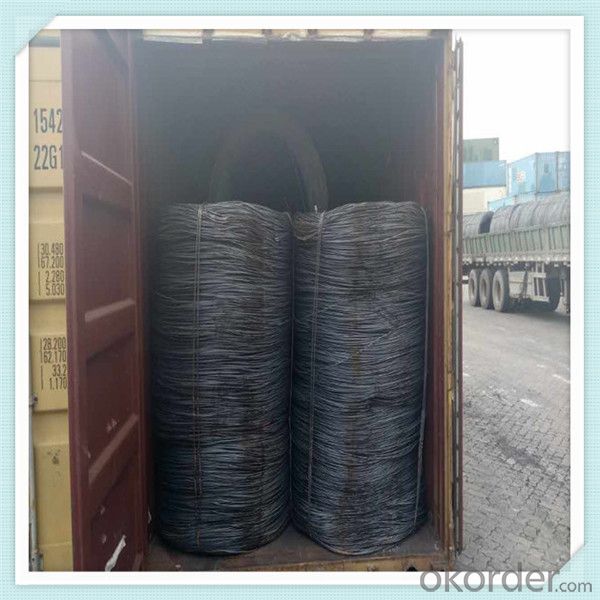
Application :
It generally used in braiding the hose for bathing product and machinery. With it
good flexibility, resistant to high temperature and resistant to corrosion, it
used widely in many industries.
Packing :
Hot-rolled wire rod is held in a unit with at least four steel straps in the
transverse direction and transported and stored without further packaging.
Before
the steel strapping is applied, the wire rod must be sufficiently compressed.
The strapping is fixed in the transverse direction with a single circumferential
strap so that the strapping does not slip and cause the coil to come apart.


Our service:
(1) We cooperate with famous factories with advanced equipment and well trained workers.
(2) We can provide factory price with trading company service.
(3) We continuously work on the improvement of our processes, guaranteeing
consistently high standards of quality to keep none compensation.
(4) We guarantee 24 hours response and 48 hours solution providing service.
(5) We accept small order quantity before formal cooperation.
(6) We deliver the agreed quality at the agreed time, reacting to changes in
customer wishes in a flexible way.
(7) Due to our volume and selling power, we have excellent freight rates with
shipping lines.
(8) We strive to always be fair and honest in our dealings with customers.
(9) We strive to work together with customers to achieve much more than we can
achieve alone.
(10) Through our passion and commitment we aim to be a market leader in all our
key markets. To maintain our position as market leader we must continue to add
value in all that we do.
FAQ:
1.Q: What's your MOQ(minimum order quantity)?
A: One full container, mixed acceptable .
2. Q: What's your packing methods?
A: Packed in bundle or bulk ..
3. Q: How can I buy CNBM products in my country?
A:Please send us an inquiry or email ,we will reply to you if there is distributor in your country
4. Q: Can we visit your factory?
A: Warmly welcome. Once we have your schedule, we will arrange the
professional sales team to follow up your case.
5. Q: How long does it take to get the product if i place an order?
A:With the process of your requirements,we will pack and deliver in 3
-7 days. If it is by sea shipment,it will take 15-45 days depending on different locations
- Q: How is steel wire rod used in the manufacturing of wire for conveyor belts?
- Steel wire rod is an essential component in the manufacturing of wire for conveyor belts. The process begins with the production of steel wire rod, which is typically done through a hot rolling process. This involves heating the steel billets to a high temperature and passing them through a series of rolling mills to reduce their diameters and increase their lengths. Once the steel wire rod is produced, it undergoes further processing to transform it into wire suitable for conveyor belts. This process involves drawing the steel wire rod through a series of dies, which progressively reduce the diameter of the wire while increasing its length. This drawing process helps to improve the wire's strength, ductility, and surface finish. The wire obtained from the steel wire rod is then typically coated with a protective layer to enhance its durability and resistance to corrosion. This coating can be done using various methods such as galvanization or applying a polymer coating. After the wire is coated, it is ready to be woven or welded into the desired configuration to form the conveyor belt. The wire can be woven together in a mesh pattern, creating a flexible and sturdy belt that can move materials smoothly along a conveyor system. Alternatively, the wire can be welded together to form a solid belt, which is often used for heavy-duty applications. In both cases, the strength and quality of the wire used for conveyor belts are crucial for ensuring the belt's reliability and longevity. Steel wire rod provides the necessary strength and structural integrity required to withstand the demanding conditions of conveyor belt applications, such as high tension, heavy loads, and continuous operation. Overall, steel wire rod plays a vital role in the manufacturing of wire for conveyor belts. It serves as the raw material from which the wire is produced and provides the necessary strength and durability to ensure the smooth and efficient operation of conveyor systems across various industries.
- Q: What is the global production capacity of steel wire rod?
- The global production capacity of steel wire rod is estimated to be around 160 million metric tons per year.
- Q: What are the major steel wire rod producing countries?
- The major steel wire rod producing countries include China, Japan, India, the United States, and Russia.
- Q: How is steel wire rod tested for straightness?
- Steel wire rod is tested for straightness using various methods. One common method is the visual inspection, where the rod is visually examined for any bends or curves. Another method is the use of a straightening machine, which applies pressure and force to straighten any bends in the wire rod. Additionally, specialized instruments such as straightness testers or laser-guided systems can be used to measure and verify the straightness of the steel wire rod accurately.
- Q: How is steel wire rod priced in the market?
- Steel wire rod is typically priced in the market based on various factors such as global supply and demand, production costs, raw material prices, and market competition. Additionally, factors like quality, size, and delivery requirements also influence the pricing of steel wire rod. Overall, it is a dynamic process where market forces play a significant role in determining the price of steel wire rod.
- Q: How is steel wire rod used in the manufacturing of wire rope swivels?
- Steel wire rod is used in the manufacturing of wire rope swivels as it serves as the raw material for producing the wire ropes. The wire rod is first drawn to the desired thickness and then twisted and braided together to form the wire rope. The strength and durability of steel wire rod make it an ideal choice for constructing wire rope swivels, ensuring they can withstand heavy loads and resist wear and tear.
- Q: How are steel wire rods used in the production of screws and bolts for construction?
- Steel wire rods are used in the production of screws and bolts for construction as they serve as the raw material for manufacturing these fasteners. Steel wire rods are first heated and then drawn into the desired diameter and length to create the wire that is used to form the threads of screws and bolts. These wires are then cut, shaped, and threaded to create the final product. The high strength and durability of steel wire rods make them ideal for construction applications, ensuring that the resulting screws and bolts can securely hold structures together.
- Q: How is steel wire rod tested for hardness?
- Steel wire rod is typically tested for hardness using a method called the Rockwell hardness test. In this test, a small indenter is pressed into the surface of the wire rod under a specified load. The depth of penetration is measured, and a hardness value is determined based on the depth of indentation. This test helps assess the wire rod's ability to resist deformation and indicates its suitability for various applications.
- Q: How is the ductility of steel wire rod evaluated?
- To assess the ductility of steel wire rod, a common method is to perform a tensile test. This test involves applying a controlled pulling force to a sample of the steel wire rod until it reaches its breaking point. Throughout the test, the elongation or deformation of the sample is measured to gauge the ductility of the material. The ductility is then determined by calculating the percentage of elongation or reduction in cross-sectional area before the sample fractures. A higher percentage signifies greater ductility, whereas a lower percentage implies lower ductility. By utilizing this evaluation technique, manufacturers and engineers can effectively determine the appropriateness of steel wire rod for various applications, including construction, automotive, and manufacturing industries.
- Q: What are the different annealing processes used for steel wire rod?
- The different annealing processes used for steel wire rod include full annealing, spheroidization annealing, and process annealing. Full annealing involves heating the wire rod to a temperature above its critical temperature and then slowly cooling it to room temperature to soften it and improve its ductility. Spheroidization annealing is a type of full annealing that is specifically used for high carbon steel wire rod to transform its brittle cementite structure into spherical carbides, enhancing its machinability and reducing the risk of breakage. Process annealing, on the other hand, is a partial annealing process that is performed on cold-worked wire rod to relieve internal stresses and restore some of its ductility without affecting its mechanical properties.
Send your message to us
SAE1012 5.5-14MM Steel wire rod hot rolled
- Loading Port:
- Shanghai
- Payment Terms:
- TT OR LC
- Min Order Qty:
- 100 m.t.
- Supply Capability:
- 14500 m.t./month
OKorder Service Pledge
OKorder Financial Service
Similar products
Hot products
Hot Searches
Related keywords
